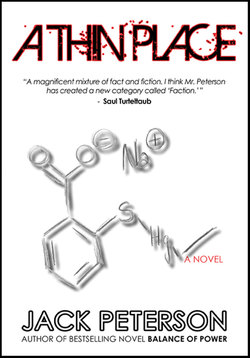Читать книгу A Thin Place - Jack Peterson - Страница 9
На сайте Литреса книга снята с продажи.
Chapter 3
ОглавлениеMay 28, 1927
Minneapolis, Minnesota
Jeremiah Trent’s office mates were gone for the weekend and he welcomed the privacy. He took a deep breath and unlocked his center desk drawer, exhaling only when he saw the backside of a small piece of well-worn paper slide slowly into view. Two days before, his project finally complete, he had penned his new formula on the reverse side. On the surface, it didn’t look like much, nothing but a series of letters, numbers, and a few symbols for some chemicals along with his initials scribbled to one side. As simplistic as the symbols appeared, everything added up. The formula could potentially change his life forever. He was looking at his future. Closing his eyes, Trent retraced the genesis of the paper resting in the center drawer.
It was last January when it all started. He was on the final day of his winter holiday in Toronto. The Canadian snowstorms were refusing to cooperate so he decided not to brave the elements and stay in. He bought a cheap mystery novel from the hotel’s newsstand along with a copy of the Toronto Daily Star.
The novel didn’t last past the first page. He dumped it in favor of the newspaper because the newspaper’s headline, Canada’s Polio Epidemic Intensifies, wouldn’t go away. His undergraduate years taught him that epidemics were as old as history, but methods to limit the damage the diseases caused were relatively new. It was in the second half of the eighteenth century when Edward Jenner, an Englishman, observed that milkmaids, unlike everyone else in the population, miraculously escaped the ravages of smallpox epidemics. Smallpox survivors were usually easy to recognize because of their hideous facial pockmarks, a lingering reminder of the effects of smallpox. When Jenner discovered that many milkmaids boasted blemish-free complexions, he theorized that their protection from catching smallpox could have been because they had previously contracted another disease. Jenner was convinced that cowpox, a much milder and less damaging version of smallpox, had produced sufficient antibodies in the milkmaids that helped them fight off smallpox during the epidemic. Jenner put his observation to the test in 1796 when he inoculated a young boy with cowpox pustules and waited. After a few days, he purposely infected the boy with smallpox. The experiment was a success. The boy didn’t get sick, and it ushered in the current era of immunization. Jenner’s experiment was considered by most historians to be the first vaccine in the history of medicine. Jenner’s success was only a start. While his theory was quickly adapted to develop vaccines to stem epidemics for many other diseases, the method of distribution was excruciating. The vaccines frequently spoiled before arrival.
Using the Canadian epidemic as his inspiration, Trent spent the entire train ride home from Toronto letting his mind go free. He knew that the problem with most epidemics was always a case of too few vaccines too late. When sufficient quantities were available, they often arrived too late because all vaccines required refrigeration to prevent the antibodies from spoiling. There simply weren’t enough properly equipped trucks or rail cars available to fill the need. There had to be a better way, he was sure of it. He saw an opportunity and took the bait.
Trent allowed himself a subtle smile as he carefully pulled the paper from the drawer. He turned it over, revealing the recipe for his creation. It was his future. He was proud.
An alkyl mercuric sulphur compound, he mumbled to himself. As innocuous as the formula appeared, the physical product was even less impressive, nothing more than a pale yellow powder. Appearance aside, the potential was impressive. The preservative could change the way vaccines were produced and help stem epidemics through mass production of vaccines. It could be his way to pay for medical school, but one hurdle remained. He harbored a shallow trust for the man that assured him that he could quietly facilitate the sale of his formula. There was also a more, one-sided, personal problem Trent knew he could never resolve. The man that potentially held the key to his future terrified him. In exactly seven days, they would meet again. Richard Gurzi was coming to Minneapolis.
